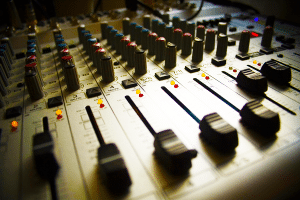What is EQ and Compression: The Basics of Home Recording (Part I)
Here at Sage Audio, we use our CD mastering services to put that final “sheen” on many projects that are recorded in home studios. Mastering these songs in our state-of-the-art professional mastering studios provides that needed bridge between the final mix of a song and a product that’s ready to be put on a CD, uploaded to the iTunes Store and/or played on the radio.

Because of this, we get lots of questions from clients working in home recording studios about various aspects of recording, including what makes a great final mix. To assist, we wanted to create a blog series aimed at musicians recording at home. In the series, we hope to touch on a wide variety of topics related to home recording studios, that will interest everyone from those just starting out in the recording field to those that have been at it for years.
In the first two installments, we want to get down to the very basics, and look at two of the most commonly asked questions by recording beginners:
- What is EQ?
- What is Compression?
These two questions are great ones to start with, because knowing about these two subjects will allow you to make the best of the equipment you have, regardless of your setup. So while we’ll look at ways to set up your home recording studios (and the best equipment you will need) in future installments of this series, effectively using EQ and Compression will make even the least expensive microphones sound much better than they would in their natural state.
What is EQ?
The simplest definition of equalization, or EQ, is that it allows you to boost the frequencies of a track that you want to highlight while cutting the frequencies that are less flattering. The easiest way to explain this is through an illustration:
When mixing an acoustic guitar, you are more than likely going to want to “roll off” a portion of the low frequencies. This means cutting all frequencies below a certain point, usually around 150 Hz or so, depending on the sound you want. Acoustic guitars produce a lot of bass response, and cutting these low frequencies will eliminate much of the low rumble that, though often not extremely audible, makes for a muddy track that can be hard to mix. On the other hand, boosting the high frequencies just a bit on your acoustic guitar track will bring out that “shine” you may want in the mix.
Short answer to What is EQ: Highlights the good parts of your instrument (or vocal) track while hiding the bad parts.
Another important use of EQ is to help tracks “fit” into a mix. The most important element of any final mix is balance – balance between left and right, balance in volume levels and a balance of low and high frequencies. Making sure the frequencies of a final mix are in balance get into a little more technical territory than we’ll go into in this blog, but here’s a quick example to show you what we mean:
Go take a quick listen to any professionally mastered song, and pay attention to the volume level of the vocal track. On almost every song, the vocal is by far the loudest part of the track – which makes sense because those working in the recording and mastering studio wanted to highlight the melody and lyrics. However, you don’t normally notice just how loud the vocal are because the frequencies are optimized to fit into the mix, so the vocals feel like they are just as loud as they should be.
Check back next week for Part II, where we’ll take a look at that other basic: compression.




